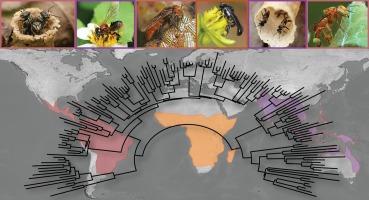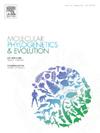无刺蜜蜂(Apidae, Meliponini)全球进化关系的系统发生学见解。
IF 3.6
1区 生物学
Q2 BIOCHEMISTRY & MOLECULAR BIOLOGY
引用次数: 0
摘要
无刺蜜蜂(蜜蜂科)以其特有的大型社会性蜂群、生产蜂蜜和其他有用产品的能力以及形态和行为的多样性而引人注目。它们在泛热带地区分布不均,主要分布在新热带、非洲热带和印度-澳大利亚地区的温暖潮湿环境中。尽管已根据形态学和分子数据提出了 Meliponini 的系统发育假说,但关于该族的进化关系和系统学仍有许多问题尚未解决。在这篇论文中,我们展示了一个大型的系统发生组数据集,该数据集由超过 2,500 个超保守元素(UCE)位点组成,测序了 Meliponini 的 153 个物种,代表了所有已知的无刺蜂属。Camargoia属、Paratrigonoides属、Plectoplebeia属、Cleptotrigona属、Ebaiotrigona属、Papuatrigona属、Pariotrigona属、Platytrigona属和Sahulotrigona属首次被纳入分子系统学分析。我们使用不同的分区策略和总结方法进行了并列分析和物种树分析。我们对几个难以解决的节点进行了基因-谱系查询(GGI),以解决恢复的树拓扑之间的不一致问题。不同分析的结果基本一致,所恢复的 Meliponini 的三个主要支系与其相关的生物地理区域一致。在主要支系中,发现了与以前工作不一致的地方。Frieseomelitta 属被认为是与 Trichotrigona 属相关的旁系,而 Lepidotrigona 属被认为是由两个独立的支系组成。尽管合并分析和加权 ASTRAL 分析大多能有效地恢复 GGI 所支持的关系,但它们在 Oxytrigona 和 Cephalotrigona 的系统发育位置上得到了不同的结果。在 GGI 分析中最受青睐的假说在其他分析中都没有发现,它与形态学证据更为一致,突出表明了通过拓扑学检验探索替代假说支持度的意义。最近,我们利用现代测序方法从古老标本中生成分子序列的能力有了长足的进步,这使得我们可以在各属之间进行无与伦比的取样,从而为无刺蜂的系统发生关系提供了一个基础,这将进一步推动对无刺蜂系统学和进化的研究。本文章由计算机程序翻译,如有差异,请以英文原文为准。

Phylogenomic insights into the worldwide evolutionary relationships of the stingless bees (Apidae, Meliponini)
Stingless bees (tribe Meliponini) are remarkable for their characteristically large social colonies, their capacity to produce honey and other useful products, and their morphological and behavioral diversity. They have a disjunct pan-tropical distribution, primarily occurring in warm and humid environments in the Neotropical, Afrotropical, and Indo-Australasian regions. Even though phylogenetic hypotheses have been proposed for Meliponini based on morphology and molecular data, many questions are still unsolved regarding the evolutionary relationships and systematics of the tribe. In this contribution, we present a large phylogenomic dataset comprising over 2500 ultra-conserved element (UCE) loci sequenced for 153 species of Meliponini, representing all known genera of stingless bees. The genera Camargoia, Paratrigonoides, Plectoplebeia, Cleptotrigona, Ebaiotrigona, Papuatrigona, Pariotrigona, Platytrigona, and Sahulotrigona were included in molecular phylogenetic analyses for the first time. Concatenated and species-tree analyses were performed using different partitioning strategies and summary methods. We performed gene-genealogy interrogation (GGI) on several recalcitrant nodes to resolve discordances among recovered tree topologies. Results were mostly consistent among analyses, recovering three main lineages of Meliponini congruent with the biogeographic domains to which they are associated. Within major clades, discordances were found in relation to previous works. The genus Frieseomelitta was recovered as paraphyletic in relation to Trichotrigona, and the genus Lepidotrigona was revealed to be composed of two independent lineages. Even though concatenated and weighted ASTRAL analyses were mostly effective in recovering the relationships favored by GGI, they retrieved different results in relation to the phylogenetic placements of Oxytrigona and Cephalotrigona. The most favored hypothesis in GGI analyses was not found in any other analyses, being more congruent with morphological evidence and highlighting the relevance of exploring the support given to alternative hypotheses through topological tests. Recent advances in our capacity to generate molecular sequences from old specimens using modern sequencing methods allowed for unparalleled sampling across genera, yielding a backbone for the phylogenetic relationships of stingless bees, which will further investigations into their systematics and evolution.
求助全文
通过发布文献求助,成功后即可免费获取论文全文。
去求助
来源期刊
CiteScore
7.50
自引率
7.30%
发文量
249
审稿时长
7.5 months
期刊介绍:
Molecular Phylogenetics and Evolution is dedicated to bringing Darwin''s dream within grasp - to "have fairly true genealogical trees of each great kingdom of Nature." The journal provides a forum for molecular studies that advance our understanding of phylogeny and evolution, further the development of phylogenetically more accurate taxonomic classifications, and ultimately bring a unified classification for all the ramifying lines of life. Phylogeographic studies will be considered for publication if they offer EXCEPTIONAL theoretical or empirical advances.

 求助内容:
求助内容: 应助结果提醒方式:
应助结果提醒方式:


